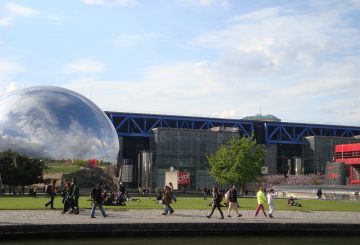Translate original post with Google Translate
A text by Vishaan Chakrabarti, about his great battle: new urbanism by hyper-densification. For him, this is the only solution for a better city, more sustainable, better transport and healthier place to live.
This extract comes from an article from this great magazine, PLACES, Building Hyperdensity and Civic Delight.
« My advocacy for hyperdense, vertical cities should by no means be misconstrued as a prescription for everyone to live in an unyielding forest of skyscrapers. It is interesting to note that even Hong Kong, the city most criticized for its relentless tower slabs, is taking steps to enable greater diversity in the size and shape of future development. Variety in building heights — modulation in architecture and scale — is critical for city dwellers to experience both sunlight and delight. Low-rise civic buildings featuring exuberant design, including museums, schools and libraries, are essential. At Columbia University, my students and I have been working on a concept I call “cap and trade zoning,” which would allow the free flow of air rights within an urban district, with an understanding that the overall amount of developable area would be capped in relation to proximity to mass transit. This would result in hyperdensity, to be sure, but would also create a “high-low” city of diverse heights, uses and ages. This concept would strengthen small businesses by permitting owners to sell their air rights, while allowing development to occur on nearby lots. Critics may argue that this approach would result in unpredictable development with varying building scales, to which I would reply “Hip hip hooray!” Much of what passes as good planning today is known as “contextual zoning,” a mechanism through which new architecture is tamed into mediocrity by mimicking a false understanding of the scale and aesthetics of existing neighborhoods. Too often this process allows a lowest-common-denominator mentality to trump the wonders of the unpredictable city. Half a century ago, in The Death and Life of Great American Cities, Jane Jacobs relentlessly critiqued the planner’s urge for control; her critique is no less pertinent today.

 While increasing density is exactly what planners and architects nationwide should be encouraging, national and local policy should be promoting hyperdensity as well. Sound urban development projects — created in concert with private developers, policymakers, design professionals and communities —represent the path to prosperity for America’s cities. In planning for hyperdensity, public officials and developers can partner to help cities meet growing infrastructure and service needs without overreliance on the federal government, which has proved far too limited in its ability to address our most pressing problems, from joblessness to global warming. »
While increasing density is exactly what planners and architects nationwide should be encouraging, national and local policy should be promoting hyperdensity as well. Sound urban development projects — created in concert with private developers, policymakers, design professionals and communities —represent the path to prosperity for America’s cities. In planning for hyperdensity, public officials and developers can partner to help cities meet growing infrastructure and service needs without overreliance on the federal government, which has proved far too limited in its ability to address our most pressing problems, from joblessness to global warming. »
Pictures are adapted from A Country of Cities: A Manifesto for an Urban America, illustrated by SHoP Architects




![[Chapter 17] Photographic collages and old masters](http://heleneherniou.com/cliophile/wp-content/uploads/2015/07/Babel-London-after-Breugel--360x245.jpeg)


Vous devez être connecté pour poster un commentaire.